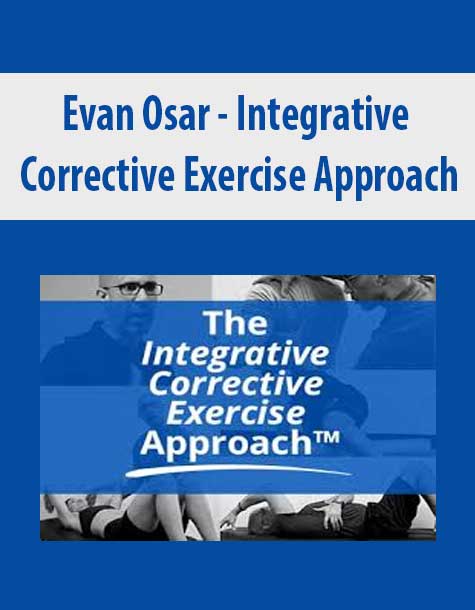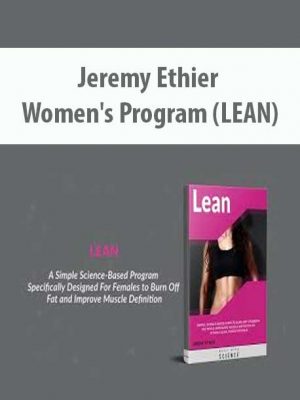Evan Osar – Integrative Corrective Exercise Approach
$299.00 Original price was: $299.00.$54.00Current price is: $54.00.
Proof of item:
We often get asked about good corrective exercise resources.
We have great resources in our catalog like the Movement book, which covers the Functional Movement Systems (the Functional Movement Screen and the Selective Functional Movement Assessment), and DVDs like Key Functional Exercises You Should Know, Applying the FMS Model and Essentials of Coaching and Training Functional Continuums, which zoom into more application specifics about corrective exercise and functional training.
But every now and again a great resource we think will be suitable for you pops up on the market.
And Evan Osar’s online course Integrative Corrective Exercise Approach (ICEA) is one of them.
We’ve gone through the whole program from top to bottom, and made a comprehensive review to help you figure out whether it’s right for you.
Note: If you decide to buy Evan Osar’s Integrative Corrective Exercise Approach, there’s a bonus On Target Publication’s offer at the bottom of the page, so don’t miss out on it.
Worth it?
- Yes.
Who should buy it
- Fitness professionals looking to learn about the underlying causes of postural and movement dysfunction, and how to use corrective exercise and smart program design to build an effective and practical training program that improves posture and movement
Pros
- Quality video demonstration of techniques and exercises with real people makes everything easy to understand
- Evan gives plenty of cues and tells you what to look out for as your clients conduct each drill, assessment and exercise
- Course is comprehensive and very well-structured
- Evan covers the principles behind postural and movement dysfunction, corrective exercise and good program design
- Evan gives three detailed case studies to help you see how to apply principles to real-world situations
- NSCA and NASM CEU approved
Cons
- Website hosting can be laggy. Sometimes videos take a bit of time to load.
- No transcripts or audio mp3s of video, which would have been helpful
Final thoughts
- This is a great resource for fitness professionals looking for a comprehensive, understandable and practical course about corrective exercise and how to apply it to real-world training programs.
In-Depth Look Inside
When you first log in to the online portal, you’ll be taken to the menu:
Evan Osar’s Integrative Corrective Exercise Approach is structured as follows:
Main Course
- Introduction
- Principles of Corrective Exercise
- Assessment
- Restoring Optimal Function
- Mindful Release
- Corrective Exercise Patterns
- Progressive Exercise Step Out Patterns
- Progressive Exercise Core Thoracopelvic Canister Patterns
- Progressive Exercise Deadlift Patterns
- Progressive Exercise Squat Patterns
- Progressive Exercise Pulling Patterns
- Progressive Exercise Pushing Patterns
- Program Design
Evan goes through the principles of corrective exercise first. He doesn’t get too bogged down in theory, so don’t worry.
He then covers assessments to identify postural and movement dysfunction and shows you his approach to restoring efficient movement and posture. He goes through both the principles underlying his approach and specific drills and exercises to use with your clients.
These are all clear and well-demonstrated in the video.
He then ties up the course with three detailed case studies of actual patients, showing you how he applies the principles and exercises in real life.
You also get some helpful bonuses to complement the main course:
Bonuses
- Bonus: Proper Sitting
- Bonus: Developing Your Business Model as a Corrective Exercise Specialist
- Bonus: Understanding Thoracic Mobility
- Corrective Exercise Solutions Assessment Manual
- Sample Corrective Exercise Program Template
- Integrative Corrective Exercise Approach Program Systems Manual
- ICEA Program Templates (contained within manual)
- ICEA CEU Exam
Below, you’ll get a deeper look at what Evan covers in each section.
Introduction
What is the ICEA?
- 10 golden rules of corrective exercise
- The most important thing when it comes to corrective exercise
- What corrective exercise really is
- The goal of the integrated corrective exercise approach
- An example of an optimal and non-optimal posture and movement strategy
- Three principles behind the integrated corrective exercise approach
- Why we need corrective exercise
- Drivers of bad postural and movement habits
The 10 Principles of ICEA
- The five things you need to understand when using the Integrative Corrective Exercise Approach
- The Fundamental A, B, Cs of the Integrative Movement System
- Why people get tight
Get Integrative Corrective Exercise Approach – Evan Osar , Only Price $57
Module 2: The Integrative Corrective Exercise Approach™ —The Principles of Corrective Exercise
Video 1: Introduction to the Principles of the Integrative Movement System™
- How the principles of movement inside the Integrative Movement System were developed
- Three reasons why breathing is important in developing optimal posture and movement
Video 2: Introduction to the Thoracopelvic Canister (Core)
- What parts of the body the core encompasses
- The purpose of the core
- What happens when you lose mobility in the core and how it impacts the rest of the body
- The key to restoring function in the core
- Why maintaining the natural curves of the spine is so important
Video 3: Biomechanics and Control of the Thoracopelvic Canister
- How the deep myofascial system differs from the superficial myofascial system
- The difference between low and high level movement strategies (including examples of movement and exercises)
Video 4: Dysfunction of the Thoracopelvic Canister
- What can cause imbalance between the deep and superficial myofascial systems
- What happens when you lose balance between the deep and superficial myofascial systems
- One of the most common compensatory strategies: a case study of a 30-year-old man suffering from low back pain
- The thing the fitness industry often focuses too much that causes lower back pain, tension and tightness
- A common dysfunction experienced after C-sections, hysterectomy, abdominal surgery and gall bladder surgery (this can cause disc injuries and low back injuries)
Video 5: Dysfunction of the Thoracopelvic Canister (continued)
- An example of dysfunction in the core in a professional athlete
- What causes disc bulges, herniations, sciatica and bone spurs in the low back (and what you need to do to prevent them from happening or getting worse)
Video 6: The Integrative Corrective Exercise Approach™ to Training the Hip Complex
- What makes up the hip complex
- What people get wrong about the psoas
- The primary and secondary function of the psoas
- How the glute max helps provide stability to the lower body
- A key to restoring optimal hip function
Video 7: Biomechanics and Control of the Hip Complex
- What neutral position of the pelvis looks like (this is vital for SI joint and back health)
- What assessment to use to help identify true anterior pelvic tilt (most clients actually have posterior pelvic tilt but look like they have anterior pelvic tilt)
Video 8: Dysfunction of the Hip Complex
- One of the most common compensatory strategies of the hip complex
- How this compensatory strategy causes posterior pelvic tilt
- One easy and obvious way to identify hip dysfunction
- Common postural cues that actually worsen hip dysfunction
Video 9: Dysfunction of the Hip Complex (continued)
- How dysfunction in the hip complex manifests itself in squats and golf swings
- How most people sit, and how common postural cues fail to address the real problem
- Early signs of an anterior hip position (if not fixed, this can cause labrum tears, and eventually the need for joint replacement surgery)
Video 10: The Integrative Corrective Exercise Approach™ to Training the Shoulder Complex
- The four primary joints that make up the shoulder complex
- The only bony attachment of the upper extremity to the axial skeleton
- How hyperextension of the rib cage causes scapular dysfunction
- What neutral position of the scapula is (how far it should sit from the spine and what angle it should sit at rest)
- How the scapula should rotate when the arm moves overhead
Video 11: Biomechanics of the Shoulder Complex
- Why people tend to experience scapular winging when lowering the arm from the overhead position
- How the scapula should move when you protract and retract your shoulders
- What to look for when assessing the shoulder complex
Video 12: Control of the Shoulder Complex and Dysfunction
- What muscles are involved in controlling the scapular (these are the muscles you should pay attention to when addressing scapular dysfunction)
- The three muscles that pull the scapular down and foward
- Common shoulder dysfunction and compensatory strategies that are caused by poor posture, surgery, injury or inflammation in the shoulder area
Video 13: Dysfunction of the Shoulder Complex (continued)
- Which exercises can make neck pain and shoulder dysfunction worse
- An easy way to tell if your clients are using a harmful compensatory shoulder strategy
- Common postural cues you shouldn’t use with clients (these perpetuate poor patterns)
- Do your clients suffer labrum tears? What to pay attention to
Module 3: The Integrative Corrective Exercise Approach™ — Assessment
Video 1 – Postural Assessment – Lateral Alignment
- What to look out for when conducting a lateral postural assessment
- A quick way to prepare and make sure your client is in the most neutral alignment possible before conducting the assessment
- What you typically see in clients who work out a lot
- An easy way to help clients determine whether they’re in anterior or posterior pelvic tilt (requires no equipment)
Video 2 – Postural Assessment – Posterior Alignment
- What to look out for when conducting a posterior postural assessment
- How glutes look when clients have dysfunction
- What you typically see in clients who are flat footed
Video 3 – Postural Assessment – Anterior Alignment
- What to look out for when conducting a anterior postural assessment
- How the hip, knee and ankle should be aligned
- Why so many people have IT band, hamstring and arch problems
Video 4 – Postural Assessment – Shoulder Alignment
- Where the scapular should sit on the thorax
- How the scapular should be angled
- Why clients tend to get shoulder issues
Video 4a – Scapular Alignment and Control
- Where the scapular should lie in relation to spinal segments
- What you shouldn’t see when a client raises and lowers the arms
- How the scapula should move in horizontal pushing and pulling movements
Video 5 – Postural Assessment – Seated Knee Alignment
- How to tell whether a client’s tibia is externally rotated relative to the femur
- Why clients tend to have an externally rotated tibia
- What stops the femur and tibia from aligning properly when running, walking and squatting
Video 6 – Postural and Breathing Assessment – Lying Posture and Breathing
- What you’ll typically see in clients when they’re lying down
- How your clients should be breathing (and how most clients actually breathe)
- How to assess rib cage mobility
Video 7 – Lying Assessment of Internal and External Rotation – Hips and Shoulders
- How to assess rotation of the hips and shoulders in a lying position
- Usual differences in internal rotation of the left and right legs
- How far people can usually internally rotate their shoulders
- What restrictions people usually have when they suffer from forward shoulder position
Video 8 – Overhead Length Assessment
- How to conduct the overhead length assessment and what to look for
- A sign that your client has short lats and thoracolumbar fascia
- An indication of tightness in the lat and teres major
Module 4: Utilizing the Principles of the Integrative Movement System™ to Restore Optimal Thoracopelvic Canister (TPC) Function
Video 1 – Developing Optimal Thoracopelvic Canister (TPC) Alignment
- How to align the thoracopelvic canister (TPC)
- Where to position your client’s leg when helping to align the TPC
- The easiest position to get someone to relax when aligning the TPC alignment
Video 2 – Developing Optimal Three-Dimensional Breathing
- How to help your clients optimize abdominal breathing
- What to do if clients can’t relax their hips
- How to help your clients optimize lateral breathing
- Why people may feel dizzy and light-headed when working on three-dimensional breathing
1 review for Evan Osar – Integrative Corrective Exercise Approach
| 5 star | 100 | 100% |
| 4 star | 0% | |
| 3 star | 0% | |
| 2 star | 0% | |
| 1 star | 0% |
Sorry, no reviews match your current selections
Q & A
Related products
Personal Development
Personal Development
Personal Development
Personal Development
Personal Development
Personal Development
Personal Development
Personal Development
Jess Lively – Magic Flow School – The Ultimate Course Bundle














AAA | Evan Osar – Integrative Corrective Exercise Approach